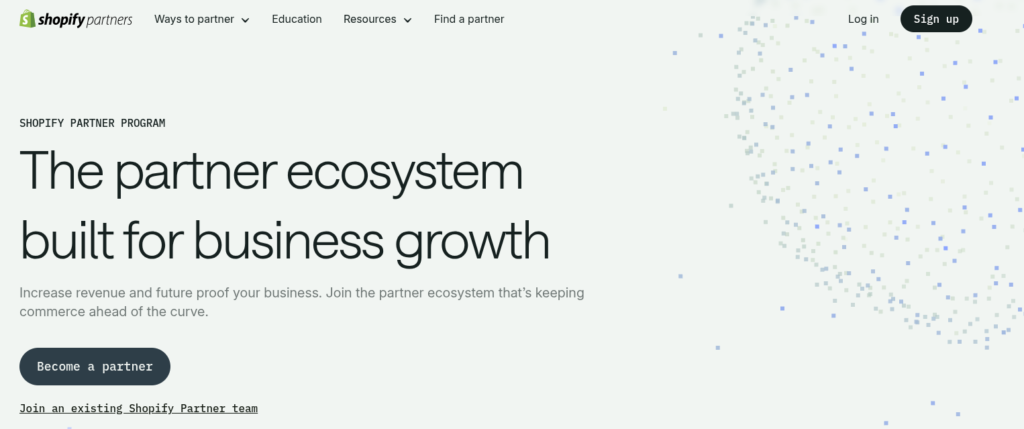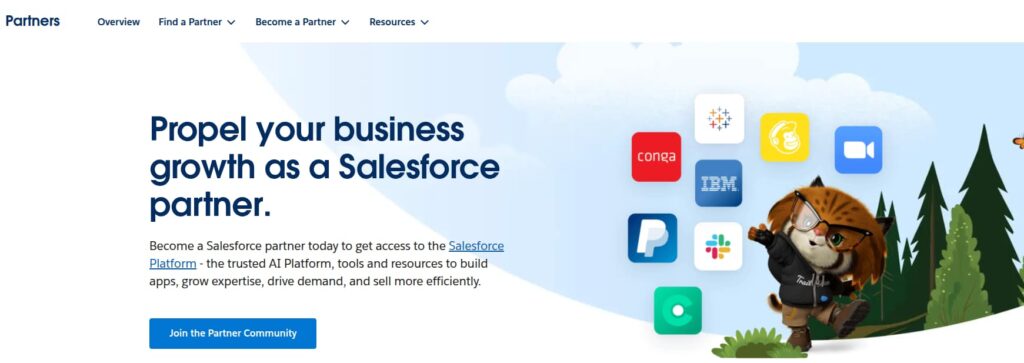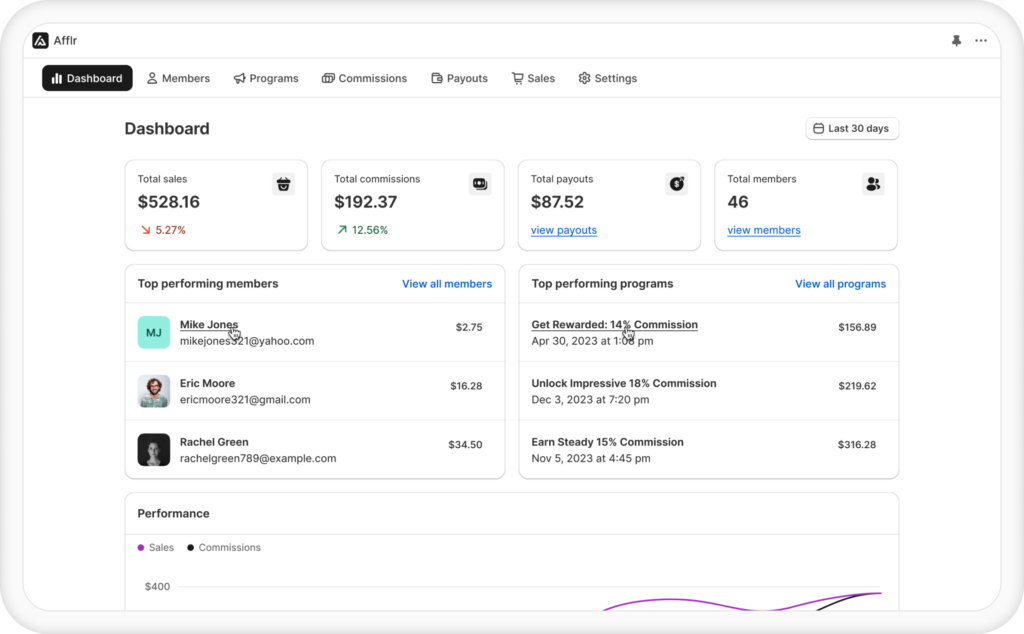A B2B referral program will not reach its full potential if you use B2C strategies.
Statistics report that 91% of B2B decision makers rely on word-of-mouth marketing. However, by simply treating your wholesale customers like your retail shoppers, you might not realize their full capability.
Therefore, in this guide, we’ll discuss everything you need to know about building successful B2B referral marketing.
In addition, you can learn step-by-step how to build your referral program for B2B, practical strategies to optimize it, and real examples to help you craft a successful campaign.
Turn your best customers into brand ambassadors who drive consistent revenue with Afflr in minutes.
What is a B2B Referral Program?
A B2B referral program is a recommendation marketing where your satisfied customers refer your brand to other businesses or key decision makers in return for a reward.
However, Relationship-based referrals aren’t just about free products or discounts.
A solid business-to-business referral program involves high-value orders, long customer lifetime value, and more complex relationship dynamics.
Consequently, a strong B2B referral strategy thrives on trust and strategic commission models that work better for long-term business relationships.
How a Referral Program in B2B Works?
Here is how the referral program in B2B works:
- Firstly, you identify happy customers or partners and convert them to brand advocates.
- Then, as part of your referral program workflow, ask them to recommend your B2B solution to relevant contacts.
- As a result, they will make introductions to potential prospects [leads]
- Following that, your team can follow up and nurture these warm leads
- Finally, when a referral becomes a customer, the referrer receives their B2B reward fulfillment.
You can learn more about lead generation with affiliate marketing to help your business.
Benefits of B2B Referral Marketing
The benefits of B2B referral marketing are:
- Lower customer acquisition costs: You will incur less cost for acquiring leads through word-of-mouth marketing for B2B word-of-mouth. Subsequently, it can be 50% less than cold outreach.
- Faster sales cycles: 88% of people trust recommendations from known sources. Therefore, you can close referral sales faster than non-referred leads.
- Higher conversion rates: A referred B2B customer is likely to convert at 3- 5x the rate of other channels.
- Better customer quality: Since your customers already know your business type and value, referred businesses have higher lifetime values.
- Network intelligence: Finally, you can gain insights into your customers’ business relationships. As a result, you can serve your customers better and retain them efficiently.
Save 15+ hours weekly on manual referral management by using Afflr. Reach 3x conversions.
How to Build a B2B Referral Program in 6 Steps
To build a B2B referral program, follow these steps,
- Define Goals and Ideal Customer Profiles
- Choose the Right Commission Model
- Build Referral Workflow
- Select the Right B2B Referral Marketing Software
- Set Up Referral Tracking and Attribution
- Train your Sales Team
1. Define Goals and Ideal Customer Profiles
Before launching the referral program for B2B, get a clear idea of:
What growth metrics do you want to improve
When starting a referral marketing for businesses, be sure of the end goal you are looking for. It could be customer acquisition, AOV, retention, or something else.
Which types of business customers do you want more of
For effective B2B referral targeting, analyze your current customer base to identify which segments are your largest contributors in sales. As a result, you can identify what type of customers you want more of.
Who could be your best referrers (not necessarily your biggest spenders)
When developing your ICP for referrals, consider who you want as customers and who makes the best brand advocates.
Following that, you can identify potential referrers based on engagement, repeat rate, feedback, and satisfaction.
2. Choose the Right Commission Model
B2B referral program incentives must not only motivate your business customers but also favour your business.
For example, cash isn’t always the driving force in the B2B ecosystem. Therefore, you can offer discounts on further orders or access to premium features.
For example, an effective B2B rewards program can have options like:
- Account credits toward future purchases
- Free premium services or upgrades
- Early access to new product lines
- Co-marketing opportunities
- Exclusive educational resources
- VIP experiences or events
Non-cash referral rewards work better when it comes to B2B referral marketing. Therefore, when you set referral commission, ensure B2B referral partner incentive alignment with these options.
3. Build Referral Workflow
Your referrals shouldn’t be an afterthought but a natural part of the customer journey. Therefore, follow B2B referral program best practices and create multiple referral touchpoints throughout the customer lifecycle.
Therefore, the best times to prompt for referrals include:
- First, after a successful onboarding
- Following that, after positive customer interactions with the support team
- Then, during quarterly business reviews
- Mainly, at product milestone achievements
- Then, when launching complementary products
Apart from this, you can have a referral landing page on your website for easy access.
4. Select the Right B2B Referral Marketing Software
Choosing the right B2B referral program software can automate the entire journey.
Hence, the key features to look for in B2B referral marketing software:
- Customizable commission and payment options
- Generation of a unique referral link and easy sharing methods
- Automated tracking to monitor attribution
- Reporting and analytics capabilities
The best referral app must be seamlessly integrated with your other business systems, especially your CRM for referrals.
When conducting a B2B referral program software comparison, prioritize platforms that satisfy the unique needs of your business.
Related Reading: Learn how to promote your referral links.
5. Set Up Referral Tracking and Attribution
You need proper B2B referral tracking so that every recommendation is monitored correctly and rewarded appropriately. Thus, you need an efficient tracking tool.
The key elements to track for your referral programs are:
- Unique referral links or codes
- Source and relationship of referrals
- Conversion status of referrals
- Referral reward fulfillment status
B2B sales cycle involves multiple decision makers and multi-touch attribution. Hence, you need a very vigilant B2B referral analytics.
6. Train your Sales Team
Once your referral program for B2B is set, begin training everyone who interacts with potential customers.
For sales team enablement, you can create the following materials to support:
- Benefits and features to highlight
- Scripts for following up with referred leads
- A referral dashboard for tracking
As part of your partner referral program, apart from customers, you can also approach vendors, suppliers, etc for referrals.
B2B Referral Program Best Practices for Higher Conversion
The best practices of B2B referral programs are:
1. A/B Test Messaging and Placement
Testing is a continuous process. Therefore, you must experiment by changing elements of your referral program to find which brings a higher response.
Test elements like:
- Copy and messaging
- Pop-ups and placement
- The timing of when you ask for referrals
- Commission and payouts
A benefit-oriented copy will increase the CTR of your B2B referral CTAs.
2. Offer Bonus to Top Referrers
You can create a VIP experience for your best advocates. As a result, they will be motivated to perform better.
Therefore, set up an effective B2B loyalty program to recognize your top 20% of referrers who generate 80% of your referred revenue. In addition, you can also offer LTV-based rewards or tiered commissions.
For B2B advocate marketing, referrer retention is as important as customer retention. Therefore, ensure regular communication and engagement with your brand advocates.
3. Full Disclosure Policy
Everyone involved in your referral marketing for B2B must be aware of everything that takes place. As a result, you can avoid conflicts and keep trust intact. Therefore, follow diligent affiliate disclosure and other legal considerations.
Best B2B Referral Marketing Tools & Software
There are several best referral marketing tools in the market. They can save time by automating the B2B referral program management and tracking.
Here are some of the popular partner referral program B2B tools:
1. Afflr (Shopify-specific):
Afflr can help you automate your affiliate marketing and referral programs in minutes. You can automate everything from sign-ups to payouts.
The speciality of this app is that all its features are free. Specifically, you only pay as you get sales.
Key Features:
- One-click setup with customizable commission structures (tiered, recurring, lifetime)
- Built-in fraud protection and automatic affiliate payout
- Seamless integration with popular tools like Klaviyo, PayPal, Tremendous, and Zapier
- Comprehensive tracking and branded affiliate dashboard
2. Viral Loops
You can create engaging referral campaigns in minutes with ready-to-use templates. Thus, you require zero coding expertise.
Specifically, you can track real-time performance while seamlessly integrating with your existing marketing stack.
Key Features:
- User-friendly campaign with customizable templates for various business types
- Built-in landing page builder for campaigns without requiring a website
- Real-time dashboard showing campaign performance broken down by channel
- Extensive integration options with email platforms and CRM systems
You can create a business referral program easily. Consequently, you can identify your top brand advocates with 14+ reward structures.
You can manage a complete client referral system. Thus, tracking every step of the journey while preventing fraud with verification.
Key Features:
- Drag-and-drop builder for creating engaging advocate dashboards
- Advanced tracking from first click to final conversion across platforms
- Comprehensive API options and mobile SDKs for seamless product integration
- Advanced fraud detection ensures only genuine referrals count
High-Converting Example of Referral Program in B2B
Some of the popular B2B SaaS referral program examples are:
Shopify’s referral partnership B2B model rewards developers and agencies for bringing merchants to their platform. Additionally, they provide all the resources needed to help partners bring referrals.
You can either join Shopify as
- Service partner: You can provide consulting or marketing services. Thus, helping brands build or migrate easily. You can get part of the sales apart from the co-marketing funds with Shopify.
- Technology partner: You can build custom apps and integrations for store owners. As a result, you can get early access to new launches, Shopify app store listing, etc.

Dropbox is a storage platform that offers referrals from the website or mobile app.
For a successful referral, you can earn 500MB (up to 16GB). In addition, Dropbox Plus can earn 1GB for every referral (up to 32GB).
Thus, their B2B SaaS referral program case study shows how you can offer alternatives to cash rewards.
Following this, you can ensure the loyalty of your referral partners and encourage them to bring more referrals.

3. Salesforce Referral Program
This is a popular B2B customer referral program that is open to technical, sales, and marketing teams.
Consequently, they offer rewards based on strategic resources, instead of cash incentives. Thus, it can help drive sustainable, long-term growth.
Salesforce encourages partners to build expertise, drive demand, and boost revenue rather than just bringing new customers.
Thus, this Salesforce partner program case study shows how a value-first ecosystem can bring tremendous growth opportunities.

Common Referral Mistakes to Avoid
Avoid these common mistakes in your referral program for B2B
- Overcomplicating the process: If it takes more than 2 minutes to make a referral, it’s too complex. Therefore, make the process easy for your referral partners.
- Weak incentives: A $25 gift card won’t motivate someone to refer a customer worth $10,000. Hence, compensate your customers adequately to keep them motivated.
- Set-and-forget mentality: Your referral programs need ongoing promotion and optimization. Hence, keep updating them for continuous success.
- Poor follow-up: Your referrals might forget you if you don’t engage with them regularly. Hence, keep in touch using affiliate email marketing.
- Ignoring the referrer after the reward: Payment on time is important to maintain your brand trust. Hence, never delay your payouts.
Grow your B2B relationships. Activate partner marketing today without the upfront costs of traditional marketing.
Conclusion
A well-executed referral program of B2B can be cost-effective and make it easy for your business to get quality leads.
B2B referral scaling is possible when enterprise referral marketing is not just a strategy but is also seamlessly integrated into your customer journey.
Therefore, implement these strategic referral partnerships to grow your B2B partner programs effectively.
Further Reading
- How to Recruit Affiliates: 9 Affiliate Recruitment Strategies
- Top 8 Affiliate Recruitment Tools for E-commerce
- 19 Effective Affiliate Marketing Strategies for Success
- What is Affiliate Management: The Ultimate Guide
Frequenty Asked Questions
To track B2B referrals, you can use referral software. In addition, you can integrate it with your CRM to monitor referred leads, attribution, and conversions.
The three types of referrals are direct referrals – customers refer other customers organically, incentivized referrals – customers refer others for a reward, and partner referrals – affiliates or business partners refer others.
A B2B loyalty program is an opportunity to reward customers when they shop with you repeatedly. It’s designed to increase retention, lifetime value, and long-term business relationships.
The different types of B2B referral networks are customer-based referral programs, partner referral systems, affiliate networks, and industry-specific communities.
A referral bonus is cash, credits, or a reward given to partners who refer a quality lead or customer to your business. Hence, it encourages advocacy and supports lead generation.
